This page is based on a document prepared by Jane King,
containing the results of her research into the war memorials in Longthorpe Church.
A copy of Jane's original document can be downloaded by clicking here

WE WILL REMEMBER THEM
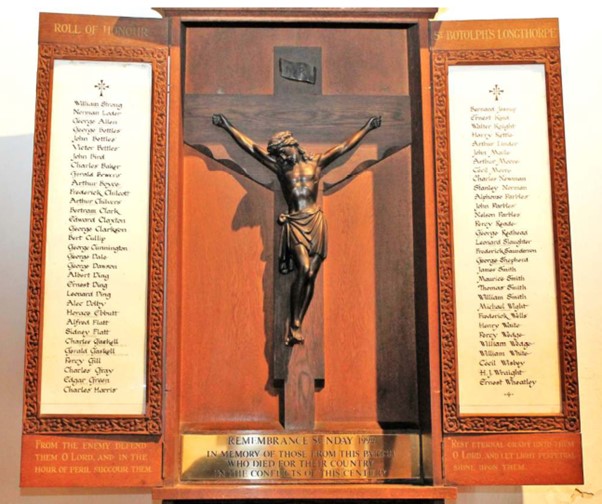
WAR MEMORIALS AND WAR GRAVES
St Botolph’s Church, Longthorpe, Peterborough, PE3 6LU
Ordnance Survey reference: TL 16304 98389
(c) Jane King 2018
St Botolph’s Church has several memorials commemorating those who died serving in the armed forces. They incorporate the Second Boer War, both World Wars and also two non-combat deaths on active service. Most of those memorials are within St Botolph’s Church, but its graveyard also contains three actual War Graves as well as two further war memorials in the form of commemorative inscriptions on family headstones. The Church also contains a First World War Roll of Honour of men connected to the village who served in the armed forces, listing both survivors and casualties.
(Longthorpe’s communal World War 1 Memorial commemorating those who died is the communion rail in St Botolph’s Church. The Parish’s World War 2 Memorial comprised the Village Hall that was opened by Captain T.W. Fitzwilliam on 6/3/1947. That structure was demolished in 2008 and replaced by the current Village Hall that officially opened on 3/4/2009).
Details of the war memorials and a brief biography of each of the casualties named upon them are outlined in the following pages. The data has been drawn from numerous sources, including the General Register Office’s birth/marriage/death indices; census records (and 1939 Register); Probate records; the Commonwealth War Graves Commission’s Casualty Registers; Medal Index Cards; service records; War Diaries; newspaper archives; etc.
Whilst care has been taken to transcribe the information accurately, the details are subject to the reader’s own verification from original records. I apologise sincerely for any error this booklet may contain.
Jane King
August 2018
INDEX
Boer War Memorials re Charles Powlett Strong D.S.O. (plaque & window; biography)
First World War Parish Memorial re those who died (i.e. communion rail)
First World War Roll of Honour of those who served, including survivors (i.e. triptych)
First World War Memorials re Lt John Horace Ebbutt (i.e tablet, reredos & family grave)
First World War Memorial re Lt Commander Gerald Bruce Gaskell (plaque)
First World War Memorial re Captain John Charles Temple Gaskell (plaque)
First World War Memorials re Lt. William Leonard Slaughter (tablet/rood)
First World War Grave of Private John William Smith
First World War casualties’ biographies
1924 Non-combat Memorial re Corporal John Leslie Shipsides (tablet & biography)
1931 Non-combat Memorial re Lt John Isham Strong (tablet and biography)
Second World War Memorial re Pilot Officer Frank Giles D.F.M. (tablet)
Second World War Memorial re Sergeant Archie Thorburn (on family headstone)
Second World War Grave of Major Norman George Orrell
Second World War Grave of Corporal Dennis John Urwin
Second World War casualties’ biographies
BOER WAR MEMORIALS
On the south wall of the nave hangs a Boer War Memorial commemorating Charles Powlett Strong D.S.O.:
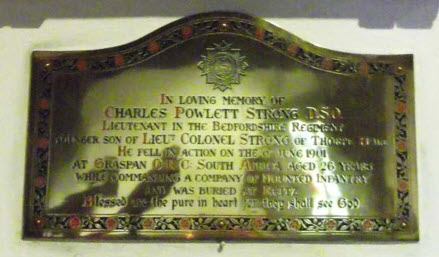
The brass plaque measures 484mms high x 824mms wide x 2mms deep. The inscription reads:
IN LOVING MEMORY OF
CHARLES POWLETT STRONG D.S.O.
LIEUTENANT IN THE BEDFORDSHIRE REGIMENT
YOUNGER SON OF LIEUT COLONEL STRONG OF THORPE HALL
HE FELL IN ACTION ON THE 6th JUNE 1901
AT GRASPAN O:R:C: SOUTH AFRICA AGED 26 YEARS
WHILE COMMANDING A COMPANY OF MOUNTED INFANTRY
AND WAS BURIED AT REITZ
Blessed are the pure in heart for they shall see God
On the south wall of the chancel is an additional memorial to Charles, comprising a stained glass window made by A.L. Moore of Southampton Row in London that depicts the Resurrection:

The associated brass plaque on the windowsill measures 80cms wide x 16cms high and reads:
TO THE GLORY OF GOD AND IN
MEMORY OF CHARLES POWLETT STRONG
On 6/8/1902 the Peterborough Advertiser reported that the window had been dedicated by Colonel Strong to his son the previous Sunday (3rd August), and that the brass plaque in the nave had also been erected.
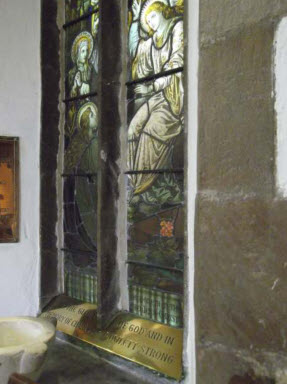
Charles Powlett Strong’s birth in Longthorpe was registered in 1875. He was the younger son of Katharine Anne nee Powlett and magistrate Lieutenant Colonel Charles Isham Strong, who had married in 1864 in Warwickshire.
On the 1881 and 1891 census Charles junior was a student, living with his parents and siblings at Thorpe Hall. Having attended Eton and the Royal Military College at Sandhurst, on 9/3/1895 the Army and Navy Gazette announced that “Gentleman Cadet Charles Powlett Strong” was joining the Bedfordshire Regiment as a 2nd Lieutenant. He was promoted to Lieutenant in 1897.
Charles was serving in the Boer War as a Lieutenant in the Bedfordshire Regiment when he was killed in action at Graspan on 6/6/1901. On 22/6/1901 the Framlingham Evening News announced a number of deaths that had occurred at Graspan, mentioning that: “Lieutenant Charles Powlett Strong, of the 2nd Battalion of the Bedfordshire Regiment (Mounted Infantry), the other officer of the regulars killed on the same occasion, had seen six years’ service. He entered the Bedfordshire Regiment in 1895 and obtained his lieutenancy in 1897. Mr Strong, who was 26 years of age, was the second son of Charles Isham Strong, Thorpe Hall, Peterborough. The deceased officer, who was educated at Eton and Sandhurst, was for some time stationed in Ireland. He left with the regiment for South Africa in December 1899, and then volunteered for the Mounted Infantry. He was a fearless horseman, and known with the Fitzwilliam Hounds and, like his father who rowed for Cambridge, he was a good all-round athlete”.
Charles was buried at Reitz main cemetery in South Africa. (His headstone there can be viewed on the eGGSA Library website http://www.graves-at-eggsa.org/main.php?g2_itemld=3093391).
On 26/6/1901 the Peterborough Advertiser reported that a service of remembrance for Lieutenant Charles Strong had been held at Longthorpe Church on 22/6/1901. The posthumous award of his Distinguished Service Order was announced in the Edinburgh Gazette on 1/10/1901. The Medal Rolls record that he was entitled to the South Africa Medal, with clasps for Johannesburg, Diamond Hill, Wittebergen and the Cape Colony. Probate records indicate that his father administered his estate.
FIRST WORLD WAR MEMORIALS
The Communion Rails
Longthorpe’s communal First World War Memorial for those who died comprises the oak communion rails within the chancel. Of the eight associated plaques that were attached to them, one is inscribed with the parish commemoration; each of the other seven bears the name and date of death of an individual casualty. (For unknown reasons, some other villagers who died in World War 1 were omitted from this memorial, three of whom have individual memorials elsewhere in the Church).
The communion rails, incorporating carvings of grapes and corn, were crafted by Messrs Andrew & Co of Westgate, Peterborough. (The relevant faculty for their installation was granted 22/4/1920). The memorial was dedicated by Canon Maskew during a ceremony at St Botolph’s on 24/12/1920.
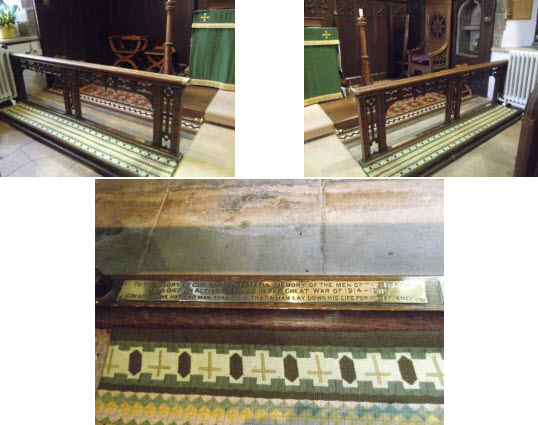
The parish memorial inscription reads:
TO THE GLORY OF GOD AND IN GRATEFUL MEMORY OF THE MEN OF THIS PARISH
WHO DIED ON ACTIVE SERVICE IN THE GREAT WAR 1914-1918
GREATER LOVE HATH NO MAN THAN THIS, THAT A MAN LAY DOWN HIS LIFE FOR HIS FRIENDS
Of the seven associated name plaques, three recorded an incorrect place of death (see biographies of Walter Knight, William Hucklesby and John Smith for details). The inscriptions read:

ALFRED G FLATT,
KILLED AT AUBERS RIDGE, MAY 9TH 1915

WILLIAM MADDOCKS,
MISSING NR. ALBERT, OCT. 1916

WALTER KNIGHT,
DIED IN HOSPITAL ROUEN, AUG. 17TH 1917

SYDNEY C. FLATT,
KILLED AT LA BASSEE, APRIL 20TH 1918

WILLIAM A. HUCKLESBY,
KILLED AT MARCHIENNES, OCT. 29TH 1918

JOHN W. SMITH,
DIED IN HOSPITAL ST DUNSTAN, FEB. 18TH 1919

JOHN H. EBBUTT,
DIED IN HOSPITAL, FEB. 21ST 1919
Longthorpe’s Roll of Honour
of those who served in World War 1
(The Triptych)
On the south wall of the nave hangs Longthorpe’s First World War Roll of Honour, which was erected in 1920 to commemorate 63 men connected to the village who had served in the armed forces in that War, including survivors. The central panel of the triptych measures 145cms high x 61cms wide x 24.5cms deep, and contains a carving of Christ crucified; each side panel is 107cms high x 30cms wide x 35mms deep. The original inscription of the mahogany triptych was in gilt-lettering on the side panels, and read:
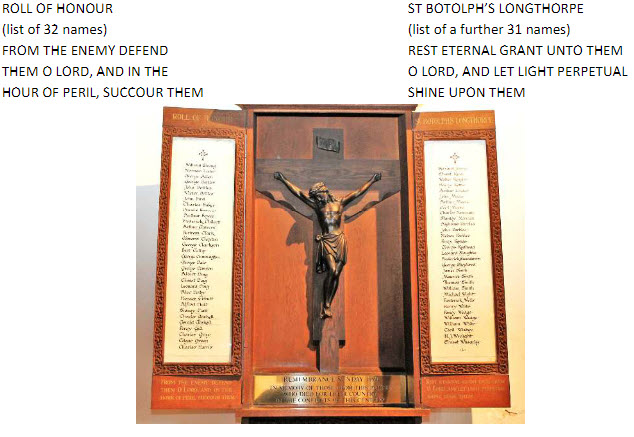
When the First World War Roll of Honour was erected in 1920 it was clearly known to all concerned thatthose listed upon it included survivors as well as casualties. In the late twentieth century, however, a misunderstanding arose that resulted in a brass plaque being added to the central panel of the triptych, inscribed:
REMEMBRANCE SUNDAY 1999
IN MEMORY OF THOSE FROM THIS PARISH
WHO DIED FOR THEIR COUNTRY
IN THE CONFLICTS OF THIS CENTURY
The attachment of that 1999 plaque has unfortunately created a false impression that the triptych is a record of parishioners who died in every twentieth century conflict. In fact, however, the triptych remains what it always was, i.e. Longthorpe’s Roll of Honour of its men who served in World War 1. (The Roll of Honour may have included some non-residents, e.g. natives who had since moved away and men working in the village but living elsewhere when they enlisted).
The following lists contain a full transcription of the ‘names’ sections of the First World War Roll of Honour, including any notations re an individual’s rank and whether they were wounded, died or were taken Prisoner of War etc.
The names section of the left panel of the Roll of Honour reads as follows:
William Strong, Brigadier General
Norman Loder, Lieutenant. M.F.H.
George Allen, Sub-Lieutenant R.N.R.
George Bettles, Prisoner of War at Limburgh
John Bettles,
Victor Bettles
John Bird
Charles Baker
Gerald Bowers
Arthur Boyce, Wounded in Action – Discharged
Frederick Chilcott
Arthur Chilvers, Killed in Action
Bertram Clark, Sergeant
Edward Claxton
George Clarkson
Bert Cullip
George Cunnington
George Dale
George Dawson
Albert Ding
Ernest Ding
Leonard Ding
Alec Dolby
Horace Ebbutt, Second Lieutenant
Alfred Flatt
Sidney Flatt, Missing
Charles Gaskell, Captain.
Killed in East Africa
Gerald Gaskell, Lt. Commander R.N., Killed at the Battle of Coronel
Percy Gill
Charles Gray
Edgar Green, Second Lieutenant
Charles Harris
The names section of the right panel of the First World War Roll of Honour reads as follows:
Bernard Jessup
Ernest Kind
Walter Knight
Harry Kettle
Arthur Linder
John Maile
Arthur Moore
Cecil Moore
Charles Newman
Stanley Norman
Alphonse Parbles
John Parbles
Nelson Parbles
Percy Reade
George Redhead
Leonard Slaughter, Second Lieutenant
Frederick Saunderson
George Shepherd, Second Lieutenant
James Smith
Maurice Smith
Thomas Smith
William Smith
Michael Wight, Second Lieutenant
Frederick Wells
Henry Waite
Percy Wedge
William Wedge
William White
Cecil Wisbey
H.J. Wraight Ernest Wheatley
Notes re the First World War Roll of Honour:
(1) The notation “M.F.H.” re Norman Loder referred to the fact that he was a Member of the Fitzwilliam Hunt.
(2) For reasons unknown, the Roll of Honour omitted William Alexander Hucklesby, William Edwin Maddocks and John William Smith, despite the fact that each of them were known to have died while serving in World War 1, and are commemorated on the communion rail.
(3) Whilst the Roll of Honour recorded that Arthur Chilvers, Charles Gaskell and Gerald Gaskell had died, those three men were not commemorated on the communion rail.
(4) The Roll of Honour omitted to mention that Alfred Flatt and Walter Knight had died, and listed Sidney Flatt as “Missing” rather than killed, even though their deaths were known and commemorated on the communion rail.
(5) The “Horace Ebbutt” listed on the Roll of Honour was in fact John Horace Ebbutt. In light of the above anomalies, the Roll of Honour is known to have contained errors; it may also have omitted the names of further parishioners who served in World War 1.
First World War Memorials commemorating Lieutenant John Horace Ebbutt
In addition to being commemorated on the Longthorpe Parish War Memorial (i.e. the communion rail – see page 5), John Horace Ebbutt is commemorated on three further war memorials at St Botolph’s, namelya wooden tablet and the reredos within the chancel, and on his family’s gravestone in the churchyard. The tablet on the south wall of the chancel measures 72cms high x 92cms wide x 5cms deep. It comprisestwo panels with castellated top; the lower corners include the crests of the Huntingdonshire and Cambridgeshire Regiments, which flank the final line of the inscription (which is from Psalm 26, Verse 8 of the Common Prayer Book). The left panel of the tablet has a raised Latin cross entwined with passionflower relief, surmounted by a crown; the right panel bears the first eight lines of the inscription.
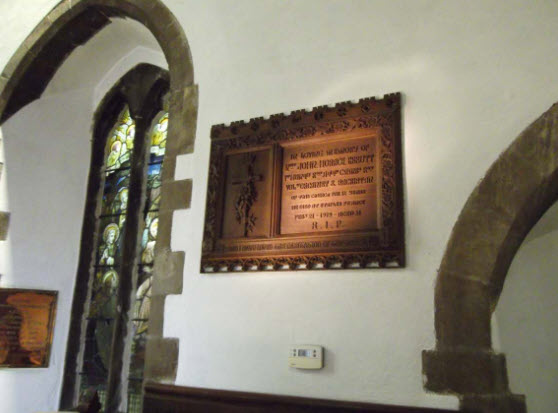
The full inscription reads:
IN LOVING MEMORY OF
LIEUT. JOHN HORACE EBBUTT
1ST HUNTS REGT. ATTD. CAMBS REGT.
VOLRY ORGANIST AND SACRISTAN
OF THIS CHURCH FOR 12 YEARS
HE DIED AT ETAPLES FRANCE
FEBY 21 – 1919 – AGE 31
R.I.P.
LORD I HAVE LOVED THE HABITATION OF THY HOUSE
The intricately-carved oak reredos on which John Ebbutt is commemorated measures 114cms high x 179cms wide x 30cms deep. (The relevant faculty for its installation was granted 28/10/1919). The reredos comprises three bays, separated by niches containing the figures of St Martin de Tours, StMichael, St Oswald and St Cecilia. The central panel bears the inscription to John, as transcribed below.

The full inscription reads:
TO THE GLORY OF GOD
AND
IN LOVING MEMORY OF OUR BOY
JOHN HORACE EBBUTT
WHO DIED ON ACTIVE SERVICE
IN FRANCE ON FEB. 21ST 1919.
THIS REREDOS IS ERECTED BY
HIS FAMILY
I WILL GO UNTO THE ALTAR OF GOD
EVEN UNTO THE GOD OF MY
JOY AND GLADNESS
A detailed report of the dedication service of the reredos on 3/11/1919 was printed in the Peterborough & Hunts Standard on 8/11/1919.
In the graveyard to the east of the Church stands an Ebbutt family headstone on which John is commemorated:
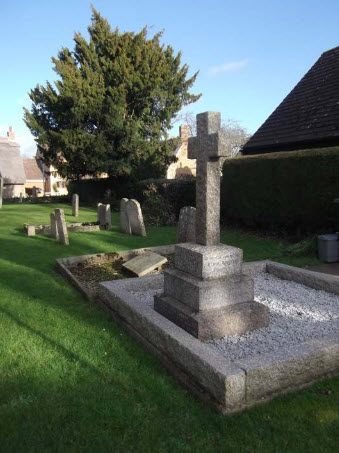
The inscription on the west face of the headstone reads:
IN LOVING MEMORY OF GEORGE EBBUTT
BORN DEC 2ND 1844
DIED NOV 7TH 1920
ALSO OF JOHN HORACE
SON OF THE ABOVE
BORN AUG 18TH 1887
DIED FEB 21ST 1919
(INTERRED IN FRANCE)
AND OF ELIZA EBBUTT
WIFE AND MOTHER OF THE ABOVE
BORN JULY 28TH 1847
DIED MAY 19TH 1924
MAKE THEM TO BE NUMBERED WITH THY SAINTS
First World War Memorial plaque re Lieutenant Commander Gerald Bruce Gaskell
A brass plaque commemorating Gerald Gaskell hangs on the south wall of the chancel. The plaque has an engraved floral border, and measures 60cms high x 46cms wide x 3mms deep:

The inscription reads:
IN LOVING MEMORY OF
REV. THOMAS KYNASTON GASKELL M.A.
FORMERLY VICAR OF THIS PARISH
WHO DIED AT COBHAM, SURREY
ON SEPT. 13TH 1915 AGED 75.
“HEAVINESS MAY ENDURE FOR A NIGHT,
BUT JOY COMETH IN THE MORNING.”
ALSO OF HIS SON LIEUT. COMMANDER
GERALD BRUCE GASKELL, R.N.
WHO GAVE HIS LIFE FOR HIS COUNTRY
ON NOV. 1ST 1914, AT THE SINKING OF
H.M.S. GOOD HOPE, AT THE BATTLE OF
CORONEL IN THE PACIFIC OCEAN, AGE 32
“JESUS ENTERED INTO THE SHIP”
(The final line of the inscription is from John 6; Verse 21).
Gerald’s brother John also died in World War 1. He is commemorated on a separate plaque – see below.
First World War Memorial plaque re Captain John Charles Temple Gaskell
A brass plaque commemorating John Gaskell hangs on the south wall of the chancel, immediately beneath the memorial re his father and brother Gerald. The plaque measures 20cms high x 38cms wide x 2mms deep, and has an engraved floral border.
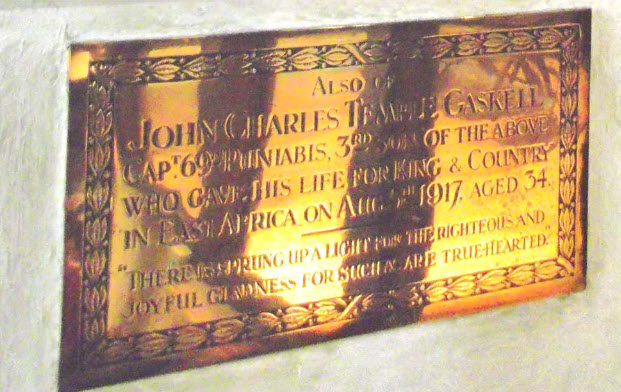
The inscription reads:
ALSO OF
JOHN CHARLES TEMPLE GASKELL
CAPT 69 PUNJABIS. 3RD SON OF THE ABOVE
WHO GAVE HIS LIFE FOR KING & COUNTRY
IN EAST AFRICA ON AUG 5TH 1917, AGED 34.
“THERE IS SPRUNG UP A LIGHT FOR THE RIGHTEOUS AND
JOYFUL GLADNESS FOR SUCH AS ARE TRUE-HEARTED”
(The final line of the inscription is from Psalm 97:11).
First World War Memorials re Lt. William Leonard Slaughter
(tablet and rood)
William Slaughter is commemorated on a marble tablet on the north wall of the chancel. The tablet, which rests upon a marble shelf, measures 46cms high x 70cms wide x 2cms deep. On the associated oak rood above the chancel screen, the central figure in 140cms wide and is flanked by two figures each measuring 75cms high. (The faculty for installing the rood was granted 2/4/1919).
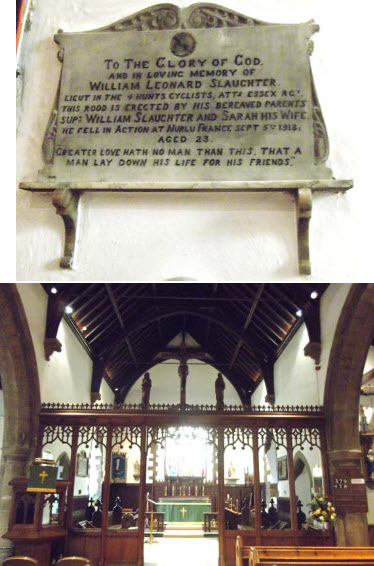
The final line of the inscription on the marble tablet is from John 15:13; the full inscription reads:
TO THE GLORY OF GOD
AND IN LOVING MEMORY OF
WILLIAM LEONARD SLAUGHTER,
LIEUT IN THE 4 HUNTS CYCLISTS, ATTD ESSEX RGT,
THIS ROOD IS ERECTED BY HIS BEREAVED PARENTS
SUPT WILLIAM SLAUGHTER AND SARAH HIS WIFE.
HE FELL IN ACTION AT NURLU FRANCE SEPT 5TH 1918,
AGED 23.
“GREATER LOVE HATH NO MAN THAN THIS, THAT A
MAN LAY DOWN HIS LIFE FOR HIS FRIENDS”
War Grave of John William Smith (World War 1)
On the western boundary of the south section of the graveyard is the War Grave of John William Smith. Rather than accepting the offer they would have received at the time to have a Commonwealth War Graves Commission’s gravestone erected, his family instead installed a stone of their choice, in the form of a wheel-cross:
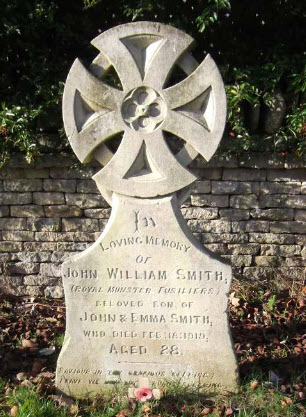
The inscription on the gravestone reads:
IN
LOVING MEMORY
OF
JOHN WILLIAM SMITH,
(ROYAL MUNSTER FUSILIERS)
BELOVED SON OF
JOHN & EMMA SMITH,
WHO DIED FEB 18 1919
AGED 28.
SAVIOUR IN THY GRACIOUS KEEPING
LEAVE WE NOW THY SERVANT SLEEPING
BIOGRAPHIES OF
FIRST WORLD WAR
CASUALTIES
WHO HAD A KNOWN/RECORDED
LINK TO LONGTHORPE
THE FOLLOWING SECTION NEEDS WEEDING,
AS FOUR OF THOSE WITH A SUPPOSED LINK TO THE VILLAGE
ARE HIGHLY DUBIOUS
The following section contains a brief biography of all 17 First World War casualties found to have had a proven or recorded link to Longthorpe. Of those 17 men, 11 are verified due to their commemoration at St Botolph’s: seven were commemorated on the Parish War Memorial (Alfred & Sydney Flatt, Maddocks, Walter Knight, Hucklesby, John W Smith and Ebbutt); three others are instead named on individual plaques within the chancel (Gaskell x 2 and Slaughter); a further man was listed on the Roll of Honour as having died, but has no plaque in the Church (Chilvers). The remaining six casualties were not commemorated in any way at St Botolph’s, but a link to Longthorpe has been found in other sources... two are from seemingly reliable “official” documents (Baldwin and Redshaw); the other four men’s reputed link to Longthorpe, however, stems from a highly dubious source ( Hawthorn, Hopkins, Albert and Luke Knight). For those four men, unless some other form of corroboration is found, I believe they should be omitted/discounted.
George Harold BALDWIN
(George Harold Baldwin was not commemorated on any memorial at St Botolph’s; he is however stated in other records to have been born in Longthorpe on 26/8/1894 as the son of George and Mary Jane Baldwin.The reason for his omission from Longthorpe’s Roll of Honour/War Memorial is most probably that George and his family were only in the village for a short time, as census records etc indicate that his father was a groom who worked in numerous kennels/stables attached to hunting estates/establishments, and that the family moved frequently).
George Harold Baldwin’s birth was registered in the Peterborough District in 1894. His Navy service file records that he was born on 26/8/1894 at Longthorpe, and that he joined the Royal Navy on 11/11/1910 under service number J/10360. When he enlisted he was 5 feet 4½ inches tall and had light brown hair, grey eyes and a fresh complexion. On the 1911 census he was recorded in Devon as a 16-year-old native of Longthorpe who was serving as a Boy 2nd Class on HMS Impregnable.
Having become a Boy Telegraphist on 28/4/1911 and served on HMS Impregnable, Queen and Vivid I, on 14/6/1912 George was posted to HMS Defiance. He became an Ordinary Telegraphist on 26/8/1912, i.e. his 18th birthday. On 26/2/1913 he became a Telegraphist. George was appointed Leading Telegraphist on 8/1/1915, while serving on HMS Blake. Having later been posted to HMS Fearless on 22/1/1917, he was appointed Petty Officer Telegraphist on 18/7/1917. (HMS Fearless was an Active-Class Scout Cruiser. In 1917 she was converted to a submarine depot ship, and served in that capacity off Murmansk from 19th October. On 15/11/1917 she returned to Britain, and in January 1918 became leader of the 12th Submarine Flotilla at Scapa Flow).
On the afternoon of 31/1/1918 approximately 40 Royal Navy vessels (including battle-cruisers, battleships and submarines) left Rosyth bound for Scapa Flow, where they were due to participate the following day in a training exercise with the Grand Fleet (i.e. Operation E.C.1). Among the fleet that left Rosyth were two flotillas of submarines, including the 12th Submarine Flotilla led by HMS Fearless. That evening, when they were near the Isle of May in the Firth of Forth, several of the fleet’s vessels collided, due to a combination of poor visibility and an order to maintain radio silence and display only dim stern lights (to avoid attracting the attention of German U-Boats). Those accidental collisions resulted in 5 vessels being damaged and two submarines (K4 and K17) being sunk, causing 104 fatalities.
George Baldwin was aboard HM Submarine K4 when she was accidentally rammed and sunk on 31/1/1918 by submarine K6. Along with all his 54 crewmates, George was drowned. As his body was not recovered for burial, he is commemorated on Panel 27 of Plymouth Naval Memorial. The Commonwealth War Graves Commission recorded him as a native of Longthorpe and as the son of George and Mary Jane Baldwin of The Kennels, Kineton, Warwickshire. His death was announced on 9/2/1918 in the Warwick and Warwickshire Advertiser, which mentioned that he was Mr & Mrs Baldwin’s eldest child.
George is commemorated on Kineton’s War Memorial and on the Guild Church of St Pattens War Memorial in London. Casualties of the accidental collisions that occurred in the incidents on 31/1/1918 are also commemorated on a memorial cairn that was erected on 31/1/2002 at Anstruther Harbour, opposite the Isle of May.
Arthur CHILVERS
(Arthur was included on Longthorpe’s First World Roll of Honour, which stated that he had died. He wasnot however commemorated on the parish’s War Memorial or on any other plaque in St Botolph’s. One possible explanation for this anomaly might be that he was living in Longthorpe when he enlisted, and therefore listed among those from the village who served, but his widow had moved to a different parish by the time Longthorpe’s War Memorial was erected after the War).
Arthur’s birth in Grimston in Norfolk was registered in 1880. Parish registers record that he was baptised on 1/8/1880 at Grimston as the son of Elijah William and Harriet Chilvers. On the 1891 census the family was living in Back Street, Grimston. By the 1901 census, Arthur was working as a page, living at Lyng Farm in Thornham All Saints in Norfolk with his parents.
Parish registers record that Arthur married Elizabeth Ellen Shirley at St Margaret’s Church in King’s Lynn on 25/2/1908. On the 1911 census he gave his age as 31 and declared that he was working as a gardener; hewas living in Castle Rising with his wife Elizabeth and their two children: Arthur and Johnny. The G.R.O. Birth Index records that their third child William was born later that year in the Freebridge Lynn District in Norfolk. They evidently later moved to the Peterborough area where (according to his obituary in the local paper) Arthur became a gardener for Charles William Bryant of Westwood House, Thorpe Road. Soldiers Died in the Great War records that Arthur enlisted in Peterborough as a Private in the Royal Fusiliers under regimental number 2882, but this later changed to 50120. The Medal Rolls record that he was first posted overseas on 11/10/1916.
The 8th Battalion Royal Fusiliers was in the 36th Brigade of the 12th (Eastern) Division. When Arthur joined them in the field in October 1916 they were serving on the Somme. By 1917 the 8th Battalion was based around Monchy-le-Preus, taking part in the Arras Offensive.
Arthur was killed in action on 19/7/1917. The Commonwealth War Graves Commission was evidently unable to locate his grave, as he is commemorated on Bay 3 of Arras Memorial in France. The Army Registers of Soldiers’ Effects recorded that his next of kin was his widow Elizabeth E. Chilvers.
On 18/8/1917 the Peterborough Advertiser reported that Private A. Chilvers of the Royal Fusiliers, who had previously worked as a gardener for Mr C.W. Bryant of Westwood House, had been killed in action on 19/7/1917 leaving a widow and three children. His Captain was reported to have written to Arthur’s widow: “I would like to offer you my deepest sympathy in the loss of your gallant husband. He died instantly and was buried at Monchy-le-Preus, France. A cheerful and willing soldier who was always ready for any duty, a brave man beloved by his comrades. We all feel his loss; he gave his life for the greatest cause Christianity ever asked of any man. My sympathy goes out to you and your children in your loss”. In addition to being named on the Longthorpe Roll of Honour, Arthur is commemorated on the Peterborough St John’s Church War Memorial. (This may perhaps imply that while Arthur was working at Westwood House in Thorpe Road, his actual home address was in St John’s parish; alternatively, his widow may have moved to St John’s parish by the time the War Memorial was erected. Either of those possibilities might explain why Arthur was listed on Longthorpe’s Roll of Honour of those who served in the War but omitted from its War Memorial). Arthur is also commemorated at Peterborough Cathedral in the First World War Book of Remembrance, which recorded his home address as Westwood Lodge, Thorpe Road (i.e. the address of his employer, Charles William Bryant).
John Horace EBBUTT
John Horace Ebbutt was listed as “Horace” on Longthorpe’s Roll of Honour. The Parish War Memorial in the chancel on which he is also commemorated bears a brass plaque that stated he died in hospital on 21/2/1919:

John is also commemorated at St Botolph’s on an individual wooden tablet (which states he died at Etaples), as well as on the reredos and on his parents’ gravestone in the churchyard (see pages 14 to 16 for details of each of those memorials).
John was born at Helpston on 18/8/1887, the son of Eliza and George Ebbutt who had married in 1870 at St Botolph’s in Longthorpe. On the 1891 census he was living with his parents in the house next to the Vicarage in Village Street, Longthorpe. On the 1901 census the family was living in the same house, which on that census was described as being in Main Road, Longthorpe. By the 1911 census John was working as an Elementary School teacher, living with his parents in Longthorpe. His tablet on the south wall of St Botolph’s chancel states that for 12 years he was voluntary organist and sacristan of the Church. Having quit his teaching job, in 1916 John joined the Army. (His Army service file is held by The National Archives under reference WO 374/21820). On 12/7/1917 the London Gazette announced that he had been commissioned from the Officers’ Cadet Corps as a 2nd Lieutenant in the Huntingdonshire Cyclist Battalion. The Medal Rolls record that his commission took effect from 26/6/1917, and that he was attached to the1st Cambridgeshire Regiment; he went to France on 26/9/1918.
On 23/1/1919 the London Gazette announced that John had been promoted to Lieutenant with effect from 27/12/1918. He was assigned to the 1/1st Hunts Cyclists Battalion, in which the Medal Rolls indicate that he was at one point Acting Captain.
The Army Registers of Soldiers’ Effects record that John died of pneumonia on 21/2/1919. His memorials within St Botolph’s Church state that he died in hospital at Etaples at the age of 31. He is buried in Etaples Military Cemetery, in grave XLV.C.4. At the request of his parents, the Commonwealth Graves Commissionincluded the following epitaph on his headstone: “The souls of the righteous are in the hand of God. Wisdom 3:1.”
In addition to being commemorated on several memorials at St Botolph’s, John is also listed in the Book of Remembrance in St Sprite’s Chapel at Peterborough Cathedral. Probate records indicate that his mother Eliza administered his estate.
Alfred George FLATT
Alfred was listed on Longthorpe’s Roll of Honour and also on its War Memorial, which stated that he died at Aubers Ridge on 9/5/1915:

Born in Peterborough in 1894, Alfred was baptised on 25/1/1896 the son of Job and Elizabeth Flatt. On the 1901 census he, his siblings and their parents were living at 131 GNR Cottages in Peterborough. By the1911 census Alfred was working as a labourer, living with his family in Longthorpe.
Soldiers Died in the Great War records that Alfred enlisted at Peterborough as a Private in the 1st Battalion Northamptonshire Regiment under regimental number 13124. The Medal Rolls record that he went overseas on 27/1/1915.
(The 1st Battalion Northamptonshire Regiment was in the 2nd Brigade of the 1st Division. It first landed at Le Havre on 13/8/1914. That year it took part in the Battles of Mons, Marne and the Aisne, as well as the First Battle of Ypres. When Alfred joined the 1st Battalion in the field in January 1915 it was in billets at Bethune in France).
The 1st Battalion’s War Diary records that on 6/5/1915 it left billets at Oblingham and proceeded to Le Touret, where it went into fresh billets. The orders it received the next day, to attack the enemy’s trenches on 8th May, were subsequently postponed for 24 hours.
At 5am on 9th May a heavy artillery bombardment of the enemy’s trenches commenced; as ordered, 40 minutes later the 1st Battalion went over the top. In the intense fighting that ensued during that day and the next in the Battle of Aubers Ridge, more than 11,000 British casualties were sustained; many of them were killed within just yards of their own trenches. The 1st Battalion Northamptonshire Regiment suffered 560 casualties in that Battle, including 17 officers.
The Army Registers of Soldiers’ Effects record that Alfred Flatt was killed “on or since 9/5/1915” and that his death was presumed; his father Job was listed as his next-of-kin. As Alfred’s body was never found/ identified, he is commemorated on Panel 29 of Le Touret Memorial in France. The Commonwealth War Graves Commission recorded him as aged 20, son of Job and Elizabeth Flatt of Longthorpe.
Alfred’s older brother Charles also died in World War (see below).
Sydney Charles FLATT
Like his younger brother Alfred (see above), Charles is commemorated on Longthorpe’s Roll of Honour and War Memorial. The Roll of Honour listed him as “Missing” rather than died; the War Memorial(which recorded him as “Sydney C. Flatt”, inferring he was known as “Sydney” to his family) states that he was killed at La Bassee on 20/4/1918:

The birth of Charles Sydney Flatt at Walsoken in Norfolk was registered in 1890. On the 1891 census he and his older siblings were living in the parish of Stanground St Thomas in Whittlesey with their parents, Job and Elizabeth. On the 1901 census the family was living in 131 GNR Cottage in Peterborough. By the 1911 census Charles was working as a farm labourer, living with his parents in Longthorpe.
Soldiers Died in the Great War records that Charles enlisted at Peterborough in the Northamptonshire Regiment under regimental number 13196. The Medal Rolls record that he went overseas as a Private on 26/7/1915, and served for a while in the 6th Battalion of the Northamptonshire Regiment. By April 1918 he had been made Lance Corporal and was serving in the 1st Battalion.
The 1st Battalion Northamptonshire Regiment’s War Diary records that on 20/4/1918 it was at Givenchy, where at 4:30am it launched an attack on the enemy’s trenches. Among the many resulting casualties was Charles Flatt. On 1/6/1918 the Peterborough Advertiser announced that he had gone missing on 20th April while serving with the Northamptonshire Regiment, attached to the Lewis Gun Corps; his parents issued a plea for information regarding his fate.
Charles body was evidently never found/identified, as the Army Registers of Soldiers’ Effects record that his death was officially presumed to have occurred on 20/4/1918. Having no known grave, he is commemorated on Panel 91 of Loos Memorial in France. The Commonwealth War Graves Commission recorded him as aged 27, son of Job and Elizabeth Flatt of Longthorpe.
Gerald Bruce GASKELL
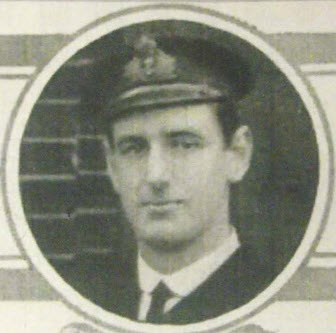
Lieutenant Commander Gerald Bruce Gaskell
(Longthorpe’s Roll of Honour listed Gerald as having served and died. He was omitted from the parish War Memorial, but was instead commemorated in the chancel on a private brass plaque.)
Gerald was born in Folksworth on 29/11/1881, the son of Horatia Octavia nee Hugo and Reverend Thomas Kynaston Gaskell. On 13/1/1882 he was baptised in Folksworth, where his father was Rector. (He was subsequently Rector of Longthorpe from 1891 to 1901, then moved to Paston in Peterborough, and later to Weybridge, Surrey; he was living at Vine House in Cobham when he died on 13/9/1915).
On the 1891 census Gerald was a boarding pupil in Shrewsbury. His service file (held by The National Archives under reference ADM 196/46/186) records that on 15/1/1896 he joined the Royal Navy. On 5/1/1898 he became a Midshipman; he was promoted to Acting Sub-Lieutenant on 15/7/1901, and to Lieutenant on 30/9/1903; his appointment as Lieutenant Commander occurred on 30/9/1911.
Gerald was at Sheerness as a Midshipman on HMS Furious on the 1901 census. His Navy file records that on 16/11/1903 he married Jane Meriel Atkinson at Brentford Register Office in Middlesex. They had three children: Geraldine Faith in 1905, Grace Meriel Hope in 1906 and Helen Dulcia Charity in 1908. On the 1911 census, Gerald was a Lieutenant on HMS Indomitable; his wife and daughters were living at 44 Lowery Road in Southsea.
In July 1914 Gerald became Lieutenant Commander of HMS Good Hope. Four months later, she took part in the Battle of Coronel, in which she was sunk off the coast of Chile on 1/11/1914, causing the loss of all 919 souls on board.
Gerald died at the age of 32. He is commemorated on Panel 1 of Portsmouth Naval Memorial in Hampshire. His death was announced on 12/12/1914 in the Illustrated London News. His address for Probate was 89 Palmerston Road in Southsea; his widow Jane administered his estate.
John Charles Temple GASKELL
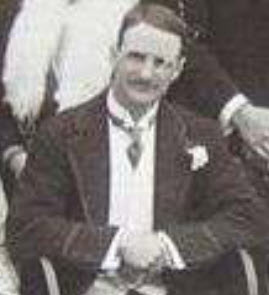
Major John Charles Temple Gaskell
(Longthorpe’s Roll of Honour listed John as having served and died. He was omitted from the parish War Memorial, but was instead commemorated in the chancel on a private brass plaque.)
John was born in Folksworth on 24/6/1883, the younger brother of Gerald (see previous page). John was baptised at Folksworth on 29/7/1883. On the 1891 census he and his brother Hugh Selwyn were boarding pupils at a school at 83 Woodside Green, South Norwood in Surrey. John later attended The King’s School in Canterbury, whose records indicate that he attended from January to December 1896 before transferring to Halleybury College in Hertfordshire, which he left in 1900.
On the 1901 census John was living with his parents Horatia and Reverend Thomas Gaskell in Paston, Peterborough. On 15/9/1901 he joined the Royal Military College at Sandhurst, from which he passed outon 30/7/1902. His commission as a 2nd Lieutenant in the Northamptonshire Regiment from 22/10/1902 appeared in the London Gazette on 21/10/1902.
On 15/1/1903 John sailed for Bombay. His transfer to the 63rd Palamcottah Light Infantry on 30/3/1904 was published in the London Gazette on 8/7/1904. His promotion to Lieutenant from 22/1/1905 appeared in the London Gazette on 30/5/1905. In August 1906 he transferred from the 63rd Infantry to become double Company Officer of the 69th Punjabi Regiment. His promotion to Captain from 22/10/1911 appeared in the London Gazette on 1/12/1911.
Having returned to England, on 7/7/1914 John married Mary Agnes Folds at St Dunstan’s Church in Woking, Surrey. (They had two children: Harriet Mary on 26/4/1915 and Elizabeth Mary in 1916). Following the outbreak of the War, John served in Egypt and also at Gallipoli, where he was wounded by shrapnel on 13/5/1915. He temporarily returned to England, but left on 16/12/1915 to rejoin his unit. His promotion to Major from 4/8/1917 was published in the London Gazette on 15/2/1918.
John was second in command of the 69th Punjabis, attached to the 129th Duke of Connaught’s Own Baluchis, when he died at Nanyabi in German East Africa on 5/8/1917, aged 34. The Commonwealth War Graves Commission records that he was initially buried at Kilwa Kivinje Cemetery, but was reinterred after the War in grave 1.AA.7 at Dar es Salaam War Cemetery in Tanzania. He is named on the war memorials ofThe King’s School Canterbury and Haileybury College, and also in Woking and at Sandhurst. Probate records indicate that his widow Mary administered his estate. Major John Charles Temple Gaskell
Frank HAWTHORN
Frank's connection to Longthorpe is tenuous, as it is uncertain if he ever actually lived in the village; it was his wife, Mary Gertrude Claxton, who was born and lived in Longthorpe. This probably explains why he was not listed on Longthorpe’s Roll of Honour or War Memorial).
Frank was born at Sunninghill in Berkshire in 1880, the son of William and Sarah Hawthorn. On the 1881census he was living with his parents and siblings at 4 Milns Cottage in Sunninghill. On the 1901 and 1911 census he was living with his widowed mother at The Rise in Sunningdale, working as a stonemason. In 1912 Frank married Mary Gertrude Claxton in the Peterborough District. (Mary was a native of Longthorpe; on the 1911 census she had been working as a ladies’ maid at Milcote, Ascot, Sunninghill in Berkshire, which is doubtless where the couple met). Their daughter Mollie was born on 15/12/1914; herbirth was registered in the Windsor District in the January quarter of 1915.
Soldiers Died in the Great War records that Frank joined the Army at Ascot. He was initially a Private in the Royal Engineers (under regimental number 180185), but later transferred to the 24th (Tyneside Irish) Battalion of the Northumberland Fusiliers, at which time his regimental number became 47834. Unfortunately Frank’s Army service record has not survived, so the date he enlisted and was posted overseas are not known. As the Medal Rolls indicate that he was not entitled to the 1914/15 Star medal, it appears he did not serve overseas before 1916.
Frank was killed in action on 13/10/1917, at which time his Battalion was engaged in the Third Battles of Ypres. He is buried in grave I.F.20 at Artillery Wood Cemetery in Belgium. The Commonwealth War GravesCommission recorded him as a native of Sunningdale, Berkshire and the husband of Mary Gertrude Hawthorn of Longthorpe. The Army Registers of Soldiers’ Effects record that Mary received a gratuity for both herself and their daughter Mollie.
Frank’s address for Probate was Laurel Cottages, The Rise, Sunningdale; his widow administered his estate. He was not listed on Longthorpe’s Roll of Honour, nor was he commemorated on the War Memorial in the chancel (most likely because he was not resident in Longthorpe at the onset of the War). In Berkshire, he is commemorated at Sunningdale on the Holy Trinity Parishioners’ War Memorial Cross.
(Frank’s widow Mary returned to Longthorpe after his death. In 1924 she married Herbert Emerton, with whom she and her daughter Mollie were living at 297 Longthorpe on the 1939 Registers).
Lawrence Hilton HOPKINS
(Lawrence was not listed on Longthorpe’s Roll of Honour or War Memorial. As the only source for his link to the village was David Gray’s books/website/WW1 Book of Remembrance in the Cathedral... all of which used local newspaper reports as a main source... it is entirely possible that Hopkins’s supposed Longthorpe link was spurious, and that he in fact had nothing to do with Longthorpe).
Lawrence was born in 1892 at Chigwell in Essex, the son of Mary and Reverend George H Hopkins. On the 1901 census he and his siblings were living with their parents at Chigwell Row All Saints. From 1904 to 1908 Lawrence attended St John’s School in Leatherhead (on whose War Memorial he is commemorated). By the 1911 census he was working as a mechanic fitter, lodging with William and Rhoda Wright at “Cloveley”, Scotney Street in Peterborough.
Lawrence’s commission on 29/8/1914 as a 2nd Lieutenant in the Huntingdonshire Cyclist Battalion appeared in the London Gazette on 25/8/1914. His Army service file is held by The National Archives under reference WO 374/34633.>/p>
Lawrence was serving as a Captain in the Huntingdon Cyclist Battalion (attached to the Cambridgeshire Regiment) when he was killed in action on 7/10/1918, aged 26. He is buried in grave VII.A.10 at Sucrerie Cemetery, Ablain-St-Nazaire in France. The Commonwealth War Graves Commission recorded him as the son of the late Reverend G.H. Hopkins and Mary Hopkins of 2 Purley Bury Avenue in Surrey. At his mother’s request, Lawrence’s gravestone bears the epitaph “Father, not my will but Thine be done”.
Lawrence’s address for Probate was Belaugh, Woodmansterne Road, Purley (which was also the contact address that was listed on his Medal Index Card).
At Peterborough Cathedral, Lawrence’s address was listed as Longthorpe in the First World War Book of Remembrance, for which much of the information was based upon casualty lists, etc., that the local newspapers had printed throughout the War.
Lawrence’s death was announced in the Peterborough Standard on 19/10/1918. The article read:
"Capt. L.H. Hopkins, attached Cambridgeshire Regt., son of the late Rev. J.H. Hopkins, Rector of Chigwell Row, and Mrs Hanslip Hopkins, Belaugh, Purley, Surrey, died on Oct 17th from wounds received in action. Capt. Hopkins, whose age was 26, formerly resided in Granville-street, Peterborough, and held an appointment as Messrs Peter Brotherhoods as assistant estimator. He was very popular with the staff ofthe firm, and also enjoyed the acquaintance of a large circle of friends in the city. Capt. Hopkins first joined the Hunts Cyclists, and was subsequently transferred to the Cambs. Regiment. He went out as recently as Sept. 28th”.
Peterborough Archives Section has a book “The Hunts Cyclist Battalion; a list of those who served”. It lists Hopkins’ address as Huntley Grove.
As far as I can see, the only source for Hopkins’ link to Longthorpe is David Gray’s description of him as such; no other record traced makes any mention of the village. I therefore have serious doubts that he ever had any connection to Longthorpe, and that the supposed link is spurious.
William Alexander HUCKLESBY
For reasons unknown, William was omitted from Longthorpe’s Roll of Honour of those who served in the War, but was commemorated on the Parish War Memorial:

(The plaque stated that he was killed “at Marchiennes”. However, the Battalion’s War Diary records that it was actually 61 kilometres south-east of that town - at Mazinghien and Catillon - when William was killed).
William’s birth in St Alban’s was registered in 1898. He was the son of George William and Elizabeth Reid Hucklesby, with whom he was living at Wimpole St Andrew’s on the 1901 census. By the 1911 census the family was living in Longthorpe; at that time, William was still at school. His father died in 1914. Soldiers Died in the Great War records that William enlisted at Northampton as a Private in the 1st Battalion Northamptonshire Regiment under regimental number 59649. As his Army service record has unfortunately not survived, the date he enlisted is unknown. He would have become legally eligible to serve overseas service at age 19.
The 1st Battalion Northamptonshire Regiment’s War Diary records that from 24th to 27th October 1918 it was at La Valle Mulatre “resting and reorganising”. On 27th October it marched via Ribeauville to the trenches just east of Mazinghien, where it immediately came under attack from shell-fire. The following day it endeavoured to reach the line of the Canal de la Sambre a L’Oise, during which it met with strong opposition from machine-gun-fire and snipers. On 29th October it attacked under a barrage, gaining most of its objectives and succeeding in capturing 15 prisoners and several machine guns. Later that day, however, the enemy “counter-attacked in strength”. By the time the Battalion was relieved on 29/10/1918, it had sustained 68 casualties, of whom 16 were killed in action; 39 were wounded and 13 were missing.
William was killed in action on 29/10/1918, aged 20. Having no known grave, he is commemorated on Panel 7 of Vis-en-Artois Memorial in France. The Army Registers of Soldiers’ Effects listed his mother as Mrs E.R. Hucklesby, whose address the Commonwealth War Graves Commission recorded as 40, Mayor’s Walk, Peterborough. That was listed as William’s address in the First World War Book of Remembrance inSt Sprite’s Chapel of Peterborough Cathedral.
Albert Edward KNIGHT
(Along with his brothers Luke and Walter, Albert’s address was listed as “Longthorpe” in the World War 1 Book of Remembrance at Peterborough Cathedral. However, although his brother Walter was listed on Longthorpe’s Roll of Honour and War Memorial, Albert and Luke were omitted from both).
Albert was born in 1890 at Hemington near Oundle, the son of Elizabeth and William Knight-Bellam (who usually used the surname “Knight”). On the 1891 census Albert, his siblings and parents were recorded in Hemington, in the home of Elizabeth’s father: William Tee. On the 1901 census the family lived at 15 Village Street in Hemington; Albert was recorded as working “on farm on Saturdays”.
By the 1911 census Albert had left home and was working as a groom and jobbing gardener, lodging at 6 Chapel Row in Stibbington. His parents were by then living in New Lane, Sibson near Wansford. Unfortunately, Albert’s Army service record has not survived, so the dates he enlisted and went overseas are unknown. Soldiers Died in the Great War records that he was living in Peterborough when he joined the Army Service Corps as a Private under regimental number M2/157056.
The Army Registers of Soldiers’ Effects record that Albert was serving in the Army Service Corps’ 629thMotor Transport Company when he died on 10/10/1916 at the 25th Stationary Hospital at Rouen. (The document did not record whether his death resulted from wounds or illness). He was buried in grave B.14.45 at St Sever Cemetery in Rouen.
The Commonwealth War Graves Commission listed Albert as a Private in 27th Battalion Army Service Corps, and his parents’ address as Sibson, Wansford. At his parents’ request, his gravestone included the epitaph “Christ will link the broken chain when we meet again, from Mother and Dad”.
Luke KNIGHT
(Like his brother Albert (above), Luke’s address was listed as “Longthorpe” in the World War 1 Book of Remembrance at Peterborough Cathedral, but he was omitted from Longthorpe’s Roll of Honour and its War Memorial. In what way Luke and Albert were linked to Longthorpe is therefore unknown).
Luke’s birth in Hemington in 1893 was registered under the surname “Knight-Bellam”, but he himself always used the surname “Knight”. On the 1901 census he was living with his siblings and parents Elizabeth and William at 15 Village Street in Hemington. By the 1911 census he was working as a gardener, living with his parents at New Lane in Sibson, near Wansford.
Unfortunately Luke’s Army service file has not survived, so the date he enlisted is unknown. Soldiers Died in the Great War records that he was living in Wansford when he enlisted at Spilsby in Lincolnshire as a Private in the 6th Battalion Lincolnshire Regiment; his regimental number was 11594. The Medal Rolls record that he went to Gallipoli on 18/7/1915.
The 6th Battalion Lincolnshire Regiment was in the 33rd Brigade of the 11th (Northern) Division. It landed at Suvla Bay in Gallipoli on 7/8/1915.
Luke was officially presumed to have been killed in action at the age of 23 on 9/8/1915, i.e. two days after landing in Gallipoli. As he has no known grave, he is commemorated on Panel 46 of Helles Memorial in Turkey. The Commonwealth War Graves Commission recorded his next of kin as William and Elizabeth Knight of Stibbington.
Walter KNIGHT
Unlike his brothers Albert and Luke, neither of whom was commemorated at St Botolph’s, Walter was not only listed on Longthorpe’s Roll of Honour but also commemorated on its War Memorial – see below. Thismay perhaps imply that he was the only one of the three brothers who actually lived/worked in the village for any length of time (or at all).

(Walter’s plaque inaccurately recorded that he died in hospital at Rouen, which had been the town in which the unit known as 12 Stationary Hospital had operated up to May 1916. In order to be more conveniently situated for receiving casualties from the Somme, 12 Stationary Hospital was relocated inJune 1916 to St Pol sur Ternoise, where Walter actually died).
Walter’s birth at Hemington was registered in 1896 as “Knight-Bellam”, but he himself always used the surname “Knight”. On the 1901 census he, his siblings and parents were living at 15 Village Street in Hemington. By the 1911 census Walter was working as a farm labourer, living with his parents Elizabeth and William at New Lane in Sibson.
Unfortunately Walter’s Army service file has not survived, so the date he enlisted is unknown. Soldiers Died in the Great War records that he enlisted at Peterborough in the Northamptonshire Regiment under regimental number 1312. The Medal Rolls record that he later transferred to the Royal Field Artillery as a Driver on 25/5/1916, at which time his regimental number became 91662.
Walter was serving in France with the 135th Battery of the Royal Field Artillery when he died of wounds on 17/8/1917 at 12 Stationary Hospital, which was at that time located at St Pol sur Ternoise. The Army Registers of Soldiers’ Effects recorded that a gratuity was paid to his mother Elizabeth.
Walter was buried in grave G.20 at St Pol Communal Cemetery Extension in France. The Commonwealth War Grave Commission recorded him as the son of William and Elizabeth Knight of Sibson, Wansford; at their request, his headstone bears the epitaph “Peace perfect peace, love to our dear boy”. Like his brothers Albert and Luke, Walter is commemorated in the First World War Book of Remembrance in St Sprite’s Chapel of Peterborough Cathedral, and also on the Sibson-cum-Stibbington War Memorial.
William Edwin MADDOCKS
For unknown reasons William was omitted from Longthorpe’s Roll of Honour of those who had served in the First World War, but was commemorated on its War Memorial:

William was born in Longthorpe in 1877, the 2nd child of John and Mary Ann Maddocks. His father was butler to Colonel Strong at Thorpe Hall, in whose Lodge the Maddocks family lived. On the 1901 census William was living with his parents, working as a proof sheet mender on the railway. On the 1911 census he was employed in the railway construction works. His mother died in 1915; his father died on 15/5/1916.
As William’s Army service record has unfortunately not survived, the date he enlisted is unknown. Soldiers Died in the Great War records that he enlisted in Peterborough as a Private in the 16th Battalion of the Notts and Derby (Sherwood Foresters) Regiment, under regimental number 70148. As the Medal Rolls indicate that he was not entitled to the 1914/15 Star medal, it appears he did not serve overseas before 1916.
The 16th Battalion's War Diary records that on 1/10/1916 it was at Hebuterne in France, and that on 5thOctober it took up post in the centre of the Thiepval Sector. During the ensuing days the enemy “made a determined attack on the Schwaben Redoubt, at the same time putting a heavy barrage on Thiepval”. The 16th and 17th Battalions of the Sherwood Foresters succeeded in driving back the enemy, but suffered many casualties in the process.
Among those who went missing at Thiepval on 8/10/1916 was William Maddocks. As he was never found alive, he was officially deemed to have died on that date. He has no known grave but is commemorated on Face 10C of Thiepval Memorial. The Commonwealth War Graves Commission recorded him as the son of the late John and Mary Ann Maddocks. The Army Registers of Soldiers’ Effects recorded that his three siblings Francis, Harry and Emma each received an Army gratuity.
On Longthorpe’s War Memorial, William’s plaque states that he went missing near Albert in October 1916.
(N.B. William is recorded in the First World War Book of Remembrance that is now at Peterborough Cathedral, but with incorrect details re his 2nd forename, rank, Regiment and date of death. This is due to the fact that, when the Book of Remembrance was compiled, his details were confused with an entirely different soldier named William Henry Maddocks, who was a Corporal in the Duke of Wellington’s (West Riding) Regiment who had died on 28/10/1916. The Book of Remembrance therefore wrongly records those details as relating to William Edwin Maddocks).
Albert Henry REDSHAW
(Albert was omitted from Longthorpe’s Roll of Honour and War Memorial, but was recorded as a native of the village on the 1901 census and by Soldiers Died in the Great War).
Albert’s birth was registered in the Peterborough District in 1887; he was the son of Mary nee Cope and stonemason Herbert Lawrence Redshaw. The 1891 census recorded him as having been born in Peterborough, and that he, his siblings and their mother Mary were living in the High Street, Kimpton, near Hitchin. On the 1901 census Albert was stated to be born in Longthorpe; he working as an errand boy, living with his siblings and their mother at 143 Wellington Street, Peterborough.
On the 1911 census Albert was visiting 153 Ledbury Road in Bayswater, and was recorded as an unemployed stonemason who had been born in Peterborough. (His parents were living in Dickens Street in Peterborough on that census). Later that year he married Harriet Craven in Yorkshire. Their daughter Florence was born in 1912.
Soldiers Died in the Great War states that Albert enlisted at Mordiford in Hertfordshire. (According to the Peterborough Advertiser, he enlisted in June 1916). Unfortunately, his Army service record has not survived. The Medal Rolls record that he joined the 16th Battalion Northumberland Fusiliers as a Corporal, and that his original regimental number TR/5/57664 later changed to 40484.
(The 16th Battalion Northumberland Fusiliers was in the 96th Brigade of the 32nd Division. Having taken part in the Battles of the Somme in 1916, in 1917 it saw action in the Operations on the Ancre and the pursuit of the German retreat to the Hindenburg Line).
The 16th Battalion’s War Diary records that on 1st April 1917 it was at Savy, whose south-west corner it reached at 2:45pm. Having dug in, it was subjected to heavy shelling. At 7:30pm it advanced into the Bois de Savy. Over the next few days it came under heavy fire, during which it sustained several casualties.
Albert Redshaw was killed in action at Savy on 3/4/1917. The Commonwealth War Graves Commission’s records indicate that he was initially buried near where he fell, but now lies in grave I.C.1 at Savy British Cemetery in France, having been reinterred after the War.
When Albert’s death was announced on 26/5/1917 in the Peterborough Advertiser, it mentioned that he had enlisted in June 1916, and that his death left a widow and one child. His death was also announced on 4/5/1917 in the Leeds Mercury, which gave his address as Myrtle Avenue, Bingley. He is commemorated in the First World War Book of Remembrance in Peterborough Cathedral (which listed his address as 13 Dickens Street) and on Bingley’s War Memorial.
William Leonard Slaughter

(William was listed as “Leonard” on Longthorpe’s Roll of Honour. He was omitted from the Parish War Memorial, but was instead commemorated on a marble tablet in the chancel – see page 18).
William was born on 13/7/1895 in Higham Ferrers, Northamptonshire, the elder child of William Slaughter and Sarah Jane nee Bates. When he was baptised at Higham Ferrers on 13/10/1895 his father’s occupation was listed as Police Constable. On the 1901 census the family was living at Hall Hill in Brigstock, Northamptonshire.
William attended Dr Knight’s School in Towcester. After the family moved to Thorpe Road in Peterborough, he joined Deacon’s School on 28/4/1909. He left on 21/12/1910 to become a solicitor’s clerk, first for Mr A.E. Craig and later at Sage’s. On the 1911 census he and his brother were living with their mother at the Police Station on Thorpe Road, Peterborough (later known as the “Sessions House”); his father, who was by then a Police Inspector, was staying in the Greyhound Hotel in Silver Street, Aylesbury on that census– he was later promoted to Superintendent. William’s brother died in 1913, aged 6.
William enlisted in January 1916 as an Acting Corporal in the Huntingdonshire Cyclist Battalion. His regimental number was originally 1762, but later changed to 290371. Having attended an Officers’ Cadet Unit, his commission as 2nd Lieutenant from 27/6/1917 appeared in the London Gazette on 16/7/1917. He served with the 1st Huntingdonshire Cyclist Battalion, on attachment to the 9th Battalion Essex Regiment. William was killed on 6/9/1918. While his unit was under heavy fire, he had gone to take cigarettes to some of his men. On his way back to his own trench, he was hit by a shell and died instantly. He was originally buried close to where he fell, but later reinterred in grave V.O.14 in Peronne Communal Cemetery in France. (The Commonwealth War Graves Commission recorded his parents’ address as 12 Thorpe Lea Road, Peterborough).
William’s death was announced on 14/9/1918 in the Peterborough Advertiser, which wrote of him that: “He was a well-known local athlete and footballer, and possessing a sunny disposition, was a great favourite with his many friends”. The report mentioned that William had been engaged to Miss Andrews, daughter of Sergeant Andrews of the Borough Police Force. On 28/9/1918, a further report stated that William’s parents had received a letter of condolence from 2nd Lieutenant H.W. Woolley. A memorial service for William held at Longthorpe Church on 29/9/1918 was reported on 5/10/1918. In his sermon, Reverend O’Reilly mentioned that William had been Assistant Scoutmaster for the Longthorpe Troop, as which he had “Always had at heart the welfare of the young lads under him; he was always ready to do a good turn and this splendid trait in his character was with him to the last, for he nobly met his death taking comforts to his men”.
In addition to being commemorated at Longthorpe, William is recorded in the First World War Book of Remembrance at Peterborough Cathedral, on the Peterborough St John’s War Memorial and on Deacon’s School’s War Memorial (of which Thomas Deacon Academy is now custodian).
John William SMITH
John was omitted from Longthorpe’s Roll of Honour, but is buried in St Botolph’s churchyard. He was commemorated on its War Memorial, which wrongly stated that he died at St Dunstan:

John was born in Longthorpe in 1891, the son of John and Emma Smith. On the 1891 census he, his siblings and their parents were living in Village Street, Longthorpe. On the 1901 census he was recorded as “William”, living with his parents at Holywell, Longthorpe. On the 1911 census he was working as a labourer at the GNR Hotel in Peterborough.
The Medal Rolls record that John enlisted as a Private in the Royal Leinster Regiment under regimental number 5594, and that he later transferred to the Labour Corps under regimental number 527095. Unfortunately his Army service record has not survived, so the dates he enlisted and was posted overseas etc are unknown; as the Medal Rolls imply that he was not entitled to the 1914/1915 Star medal, he apparently did not serve overseas before 1916. (He was reportedly wounded while serving on the Somme, which was doubtless the reason why he later transferred to the Labour Corps).
John died in Duston War Hospital in Northampton on 18/2/1919 at the age of 28, from acute double-pneumonia following influenza; at that time he was serving in 682 Agricultural Company of the Labour Corps. His death was announced on 21/2/1919 in the Northampton Mercury, which stated that the V.A.D. was in the process of arranging for his funeral to take place in Longthorpe.
John is buried at St Botolph’s in Longthorpe, near the west boundary of the churchyard. Whilst it is a War Grave, his family chose to erect a private headstone rather than accepting the offer of a Commonwealth War Graves Commission stone.
In addition to his commemoration on Longthorpe’s War Memorial (which mistakenly recorded his place of death as “St Dunstan”), John was included in the First World War Book of Remembrance in St Sprite’s Chapel of Peterborough Cathedral. (His entry in that book incorrectly recorded his date of death as 8/2/1919).
Notes regarding Longthorpe’s Roll of Honour of those who served in the First World War
The Charles Baker named on the ROH has been listed in Longthorpe’s spreadsheet as possibly the CharlesBaker of Wellington Street P/B who died on 28/10/1916... but this appears extremely doubtful. CWGC’s record of that particular man does not mention Longthorpe, nor is there any military record that links him to the village. There appears therefore to be no actual evidence that he was the man named on Longthorpe’s ROH.
“Baker” is a very common surname, and “Charles” was an extremely common forename. (There were three “Charles Bakers” within Peterborough alone who died in WW1, let alone many others from the surrounding villages/area). Longthorpe’s ROH did not indicate that its Charles Baker died, so the “default” should be to presume he survived unless some form of tangible proof can be found that identifies him as a casualty.
As no “Charles Baker” was listed in Longthorpe on any census, the chap named on the ROH may just have been living in the village temporarily when he enlisted; alternatively, he might have been included on the ROH simply because he was working in Longthorpe (but actually living outside the parish) when he enlisted.
As the name is so common, and there are far too many “ifs” involved, it would be wisest to assume that the ROH was accurate in not identifying Longthorpe’s Charles Baker as a casualty.
The speculation on Longthorpe’s spreadsheet that the James Smith named on the ROH might have been a chap who died in Peterborough on 6/10/1919 is definitely wrong, as GRO states he was aged 46. The man listed on Longthorpe’s ROH seems almost certain to have been the James Robert Smith born 1895, who was living in Holywell with his parents John and Emma when he enlisted in 1913 in the Royal Field Artillery under regimental number 891225. His Army service record indicates that he contracted influenza in France on 9/12/1918, was treated at 22 General Hospital in France and then at the Auxiliary Hospital at Bromborough, and was discharged from the Army in February 1919. He cannot, however, have been the James Smith of 118 Wards Lane Peterborough who died on 6/10/1919, as that man was recorded by GRO as being aged 46, i.e. he had been born 1873, and was therefore too old. (With a name like Smith, it is difficult to be certain, but the James Robert Smith from Longthorpe who had served in the RFA was most probably the man of that name of St John’s Close, Thorpe Road, who died aged 69 on 27/9/1964, i.e. right age/location. Much would depend on what his death cert gave as his occupation etc). Even if the “James Smith” on Longthorpe’s ROH was someone other than the James Robert Smith of Holywell who served in the RFA, as the ROH did not indicate that the person it was referring to was a WW1 casualty, it seems most probable that the Longthorpe chap survived the War. Whilst it is theoretically possible that the ROH “forgot to mention” he had died, with such a common name, unless tangible/irrefutable evidence is found that actually proves he was a casualty, it would be wisest to presume that he survived.
Charles Percy Jolley, regimental number 40239, of the Royal Irish Rifles. The casualty list dated23/10/1917 described him as being “of Longthorpe” when he was wounded, yet he was not included on Longthorpe’s ROH of servers. He appears to have survived the War. (If the Casualty List was accurate in describing him as a Longthorpe man, then it would indicate that the ROH omitted some names.
INTER-WAR NON-COMBAT DEATHS ON ACTIVE SERVICE
Non-combat death on active service of Corporal John Leslie Shipsides
A simple marble tablet commemorating John Shipsides hangs on the north wall of St Botolph’s chancel. Measuring 345mms high x 425mms wide x 30mms deep, the tablet incorporates the carved fleur-de-lys and motto of the Boy Scout Association.
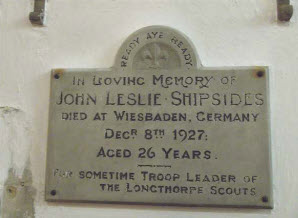
The inscription reads:
READY AYE READY
IN LOVING MEMORY OF
JOHN LESLIE SHIPSIDES
DIED AT WIESBADEN, GERMANY
DECR. 8TH 1927:
AGED 26 YEARS.
FOR SOMETIME TROOP LEADER OF
THE LONGTHORPE SCOUTS.
John was born at Bulwell in Nottinghamshire in 1901, the son of George William Shipsides and Louisa nee Hucknall, whose marriage in Nottingham was registered in 1901. George Shipsides, who had been born in Nottinghamshire, was a gardener; his wife Louisa had been born in Melbourne, Australia.
By the 1911 census John and two younger siblings (who had both been born in Bottesford in Leicestershire) were living with their parents in Longthorpe. On the 1939 Registers John’s parents were living at Thorpe Hall in Thorpe Road, of which George was head gardener and his wife Louisa was a household caretaker. The memorial in St Botolph’s indicates that John Troop Leader of the Longthorpe Scouts Troop. On an unestablished date, he enlisted in the 1st Battalion Oxfordshire and Buckinghamshire Light Infantry under regimental number 5373564; he was later attached to the 2nd Dorsetshire Regiment.
John was serving as a Corporal on attachment to the 2nd Dorsetshire Regiment in Germany when he died at the age of 26; his death certificate records that he died from lymphatic leukaemia in the Military Hospital at Wiesbaden. (Although unverified, it seems most probable that he was buried in Wiesbaden Cemetery). The Army Registers of Soldiers’ Effects record that a gratuity was paid to his parents.
John’s address for Probate was Longthorpe, Peterborough; his estate was administered by his father.
Non-combat death on active service re Lieutenant John Isham Strong
A marble tablet commemorating John Isham Strong hangs on the north wall of St Botolph’s nave. (The relevant faculty was granted on 14/6/1934). Measuring 64cms high x 46cms wide x 5cms deep, it reads:
To the glory of God
the organ in this church
was rebuilt and enlarged.
In loving memory of
JOHN ISHAM STRONG
Lieutenant 89th Field Battery
Royal Artillery
Who died at Ajmir India,
From injuries received at Polo
the 12th of December 1931
Aged 28,
son of Brig-General Strong
C.B., C.M.G., late R.A.
Fortis et fidelis
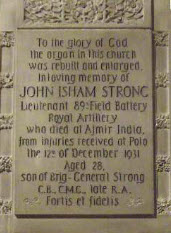
John was born at Preston in Lancashire in 1903, the only son of Katherine Mary nee Powlett and Brigadier General William Strong (whose brother Charles Powlett Strong died in the Boer War).
On the 1911 census John, his sister and their mother were in Army married quarters in India, where John’s father was serving with the 80th Battery of the Royal Field Artillery.
John was educated at Copthorne School in Sussex and at Harrow before entering the Royal Military Academy at Woolwich as a Gentleman Cadet. On 26/8/1924 the London Gazette announced that he had been commissioned as a 2nd Lieutenant in the Royal Artillery. He went to India in 1927.
In 1931 John was serving in India with the 89th Field Battery of the Royal Artillery when he took part in a polo match at Ajmer between the Battery Team and Rajkumar College. During the first chukka, John’s pony collided with one of the college mounts and was thrown. Having landed heavily on his head and been knocked unconscious, he was taken to Ajmer hospital where he died the next day from concussion.
John died at Ajmer on 12/12/1927, aged 28. He was buried at Nasirabad Cemetery. He is commemorated at the Garrison Church in Nasirabad on a plaque which reads: "To the Glory of God and in memory of John Isham Strong Lieut. 89th Field Battery Royal Artillery, who died from injuries received from polo at Ajmer 12th December 1931. Only son of Brig. General W. Strong C.B., C.M.G., late R.A. Fortis et Fidelis”.
John’s address for Probate was his parents’ home: Lady Anne’s House, Stamford, Lincolnshire. His father William administered his estate.
SECOND WORLD WAR MEMORIALS AND GRAVES
Longthorpe’s World War 2 Memorial comprised the Village Hall that was opened on 6/3/1947. Whilst no actual plaque bearing the names of those who had served/died in that conflict was erected, the village does have two individual War Memorials at St Botolph’s Church, i.e. Frank Giles and Archibald Thorburn, and the graveyard contains two War Graves, i.e. Norman George Orrell and Denis John Urwin. Further individuals connected to the village are also known to have died in World War 2, namely Arthur Charles Barlow, William Frederick Roy Draycott and Raymond Denis Stanford. The following sections have details of all seven of those casualties.
Arthur Charles BARLOW
Arthur is not commemorated on any memorial at St Botolph’s. The Japanese Index Cards of Allied Prisoner of War Cards (held by The National Archives) recorded that he was born on 8/8/1906 at 1 Holywell, Longthorpe, Peterborough, which is only partially accurate. Arthur was in fact born at Weston Hills in Lincolnshire, and his birth was registered in Spalding.
Arthur was the son of Samuel and Eliza Emma Barlow. On the 1911 census he and four of his six older siblings were living with their parents at Weston Hills, Spalding. His two brothers and their father (who was a native of Newborough near Peterborough) were working as farm labourers.
It appears that, as an adult, Arthur was usually known by his 2nd forename as, when he married Ivy Lilian Clarke in the Peterborough District in 1934, he did so under the name “Charles Arthur Barlow”. On the 1939 Registers Ivy was living at 4 Holywell, Longthorpe.
Arthur joined the 1st Battalion of the Cambridgeshire Regiment as a Private, under regimental number 5823535. The History of the Cambridgeshire Regiment (by Patrick Macdonald) records that the 1st Battalion spent the first year of the War on defence duties along the Norfolk coast. After a period of training, it embarked for service in the Middle East. While in transit, it was diverted to India, following Japan’s entry into the War. After a brief spell in India, the 1st Battalion transferred to Singapore, where it took part in the final battles for that island.
On 8th/9th February 1942 Japanese forces invaded Singapore. For the next seven days Allied forces, short of weapons and air support, fought in the Battle of Singapore in which they suffered heavy losses. Despite their valiant efforts, on the 15th of February 1942 Lieutenant General Arthur Percival was forced to surrender to the Japanese Army, and all surviving Allied forces on the island became Prisoners of War. Many of those taken Prisoner on Singapore were forced to help build the notorious Burma-Siam railway. During its construction, some 13,000 Prisoners of War died and were buried along the railway. (Some 80,000 to 1000,000 civilians also died during the project, most of them forced to work on it having been conscripted in Siam and Burma or imported from Malaya and the Dutch East Indies). After the War, the graves of those who had died during the project (apart from Americans, whose remains were repatriated)were transferred from the former Prisoner of War camps and isolated sites along the railway to three cemeteries, namely Thanbyuzayat in Myanmar and Chungkai and Kanchanaburi in Thailand.
Arthur Barlow was among those taken Prisoner of War on Singapore in February 1942. Having survived thenext three and a half years in captivity, he died on 31/7/1945. He is commemorated on Special Memorial9.M.9 in Kanchanaburi War Cemetery in Thailand. (The Commonwealth War Graves Commission’s notes re that Cemetery record that Kanchanaburi lies just a short distance from the former “Kanburi” Prisoner of War base camp, through which most of the Prisoners passed on their way to other camps).
The Commonwealth War Graves Commission recorded Arthur as the son of Samuel and Emma Barlow, and the husband of Ivy Lilian Barlow “of Peterborough”*. For unknown reasons, he was omitted from the World War 2 Book of Remembrance that is now in St Sprite’s Chapel of Peterborough Cathedral. He is however, commemorated on the Roll of Honour of the 1st & 2nd Battalion Cambridgeshire Regiment in a book that was compiled by the Commonwealth War Graves Commission.
(*In 1946 Arthur’s widow married Walter Gilbert in Peterborough. She died in Wellingborough in 1984).
William Frederick Roy DRAYCOTT
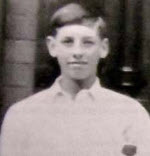
William Draycott (who was known as “Roy”) has no memorial at Longthorpe St Botolph’s. He was born on 19/2/1914, the son of Sarah Ann nee Culpin and Henry Draycott (who, on the 1911 census, had been living at 496 Gladstone Street in Peterborough with their three children. Henry was a railway engine stoker).Deacon’s School Admittance Registers record that William joined the School in 1924. He played on the cricket team in 1929 (as depicted in the above photo) and on the rugby team in 1930.
By June 1936 William was living in Foster Hill in Bedford, which was the address he gave when he was fined £1 for driving a motor-cycle at 43 miles per hour in Goldington Road on 3/6/1936. (This was reported in the Bedfordshire Times and Independent on 19/6/1936). He was working for Lipton’s Ltd.
At the start of World War 2 William joined the Grenadier Guards under regimental number 2619077. He was a Guardsman when he married Hilda Dakin at St Cuthbert’s Church in Bedford on 31/8/1940, which the Bedfordshire Times and Independent reported on 6/9/1940. Their daughter Carol was born in 1942.
In September 1944 William was a Lance Serjeant in 1st Battalion the Grenadier Guards when they fought in the Battle of Nijmegen. The objective was to capture Waal Bridge, so Allied troops could reach Arnhem. William died on 20/9/1944, and was originally buried at Nijmegen; he was later reinterred and now lies in grave 22.G.1 of Jonkerbos War Cemetery in the Netherlands. At his family’s request, William’s headstone at Jonkerbos was inscribed “Remembrance. Loving wife and daughter Carol, father and mother”.
On 13/10/1944 the Bedfordshire Times and Independent announced: “Killed in Action. Serving with the British Liberation Army, Sergt. William Frederick Roy Draycott, Grenadier Guards, of 95 Howbury St., Bedford, has been killed in action recently. Sergt. Draycott, who was thirty years of age, was the youngest son of Mr and Mrs Draycott of Peterborough. He was formerly employed by Messrs Liptons Ltd of Bedford,and was transferred to their Northampton branch, where he remained until joining up. He was a very keen footballer. Sergt. Draycott married in 1940, and is survived by a widow and a two-year-old daughter”.
On 10/11/1944 the Peterborough Standard wrote: “The Late Sgt Draycott. The widow of Sgt Roy Draycott, Grenadier Guards, whose death in Holland we announced, has received a touching letter from his C.O. LtCol Couldburn. He said it was due to the courage of the deceased and others that they were able to overcome the defences guarding the bridge. He continued: ‘Sgt. Draycott had rendered most valuable service to my Battalion, both in England and abroad, and had proved himself to be both brave and cool-headed – two most valuable attributes. I knew him well myself, and feel I have lost a good friend, and I know what his loss to my Battalion and the Regiment means. Such splendid men are very difficult to replace’. A requiem was held at Longthorpe Church recently and his name was read with others of the Brigade of Guards at Chelsea Barracks Chapel memorial service. He was the son of Mr and Mrs Draycott of 15 Springfield Rd, was an Old Deaconian and well-known sportsman. Aged 30, he leaves a widow and a young daughter”.
William is commemorated in the World War 2 Book of Remembrance in St Sprite’s Chapel of Peterborough Cathedral (which lists his address as 15 Springfield Road, i.e. his parents’). He is also commemorated on Deacon’s School’s World War 2 Memorial (of which Thomas Deacon Academy is now custodian).
Frank Giles, D.F.M.
A marble World War 2 Memorial commemorating Pilot Officer Frank Giles hangs on the north wall of St Botolph’s chancel. It measures 17cms high x 33cms wide x 3cms deep, and is inscribed:
PRAY FOR THE SOUL OF
P.O. FRANK GILES. R.A.F. D.F.M.
WHO DIED FOR HIS COUNTRY
OVER GERMANY,
MAY 13TH 1943
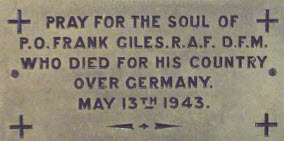
Frank Giles was born in the Wisbech District in 1911, the son of schoolmaster Frederick William Giles and Agnes Rachel nee Steward who had married in 1893 in Norfolk. (On the 1911 census Frederick and Agnes were living at Lynn Road in Clenchwarton with their six children: Lily, Winnie, Marjorie, George, Fred and Helen).
Frank’s father’s death at the age of 66 was registered in King’s Lynn in 1924. On the 1939 Registers Frank’s mother Agnes was living at 28 West Parade in Peterborough with her two youngest daughters: Marjorie, who was by then a teacher, and Helen who was a housekeeper. (As the family later erected the War Memorial tablet commemorating Frank in the chancel of St Botolph’s, it appears they attended Longthorpe Church. Agnes’ death in 1942 was registered in the Peterborough District).
In the late spring of 1939 Frank married Winifred Joyce Collingwood at Scunthorpe in Lincolnshire, where their two sons were subsequently born in 1940 and 1942.
Frank joined the Royal Air Force under service number 144766. He was assigned to 156 Squadron (Bomber Command), with which he flew the first of his 24 missions as Navigator on 2/10/1942. On 10/3/1943 the Lincolnshire Echo announced that Acting Flight Sergeant Frank Giles of Scunthorpe had been awarded the Distinguished Flying Medal. (The award was published on 12/3/1843 in the London Gazette, which on 8/6/1943 announced his promotion to Pilot Officer with effect from 1/1/1943).
W.R. Chorley’s Bomber Command Losses of the Second World War records that at 00:13 on 13/5/1943, Lancaster aircraft serial number ED857 GT took off from RAF Warboys bound for Duisburg with Frank aboard as Navigator. It crashed in the target area with no survivors. All 7 bodies were purportedly taken to Dusseldorf and the Nordfriedhof for burial, but six are now buried in the Reichswald Forest War Cemetery, while Frank now lies in Hotton War Cemetery in Belgium. (The Commonwealth War Graves Commission records that his body was reinterred in grave VII.C.9 at Hotton War Cemetery on 4/3/1948, having been recovered from the U.S. Military Cemetery at Neuville-en-Condroz. Why he was initially buried there, separated from his crewmates, remains a mystery).
At his widow’s request, Frank’s gravestone in Hotton War Cemetery bears the inscription “Years pass by as if on wings, but deep in our hearts his memory clings”. His death was announced on 27/8/1943 in the Yorkshire Post and Leeds Intelligencer, which stated he had been missing since May. His address for Probate was 87 Newland Avenue, Scunthorpe; his widow Winifred administered his estate.
Norman George Orrell
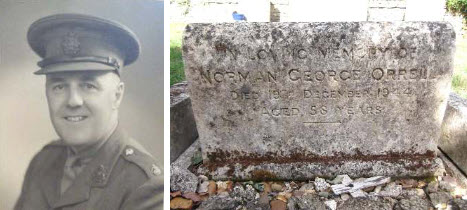
Norman has no memorial inside St Botolph’s, but its churchyard is the site of his War Grave, near the southern boundary of the south section. Instead of a Commonwealth War Graves Commission gravestone, his next-of-kin instead opted to erect a stone of their choice (as shown above). Its inscription reads:
IN LOVING MEMORY OF
NORMAN GEORGE ORRELL
DIED 19TH DECEMBER 1944
AGED 58 YEARS
Norman was born on 12/9/1886 in Blackrod in Lancashire, where he was baptised as the son of Margaret and John Ralph Orrell on 2/12/1886. On the 1891 census Norman and his sister were living with their widowed father and grandmother at 74 Church Street, Blackrod.
Norman gave his occupation as Head Teacher when he married Elizabeth Leigh on 23/7/1908 at Aspull in Lancashire. On the 1911 census they and their year-old daughter were living at 10 Sovereign Road, Wigan. In the First World War Norman’s commission as a 2nd Lieutenant in the East Lancashire Regiment was published in the London Gazette on 24/9/1915. On 2/11/1917 the Yorkshire Post and Leeds Intelligencer announced his promotion to Lieutenant. He went to France as a Captain in the East Lancashire Regiment in March 1917.
After the War, the Yorkshire Post and Leeds Intelligencer announced Norman’s appointment as Acting Captain in the King’s African Rifles. He was recorded on a ship’s manifest as Major Norman George Orrell, returning to the UK from Africa on 23/6/1924.
Norman and his wife Elizabeth separated in 1934. In 1937 he was listed as a voter at 43 Grove Hall Court in Westminster; also listed as a voter at that address was a Miss Kathleen Taylor. In June 1939 Norman’s wife was granted a Decree Nisi. On the 1939 Registers Norman and Kathleen Taylor were living at Stonecross House in Uckfield, Sussex. The couple’s marriage in Uckfield was registered in 1940.
On 13/2/1940 the London Gazette announced that Major Norman George Orrell, formerly of the East Lancashire Regiment, had been appointed as a Lieutenant in the Border regiment on 11/1/1940; his Army service number was 115287. (The unit in which he served was one of the Home Defence Battalions that were set up around that time, staffed primarily by Army veterans whose age/fitness-level precluded them from battlefield service, but whose military experience was valued on the home front).
By late 1944 Norman was serving in the Peterborough area. He died on 19/12/1944 in Peterborough at theage of 58, and was buried near the southern boundary of St Botolph’s churchyard, where his War Grave is marked by a private stone. The Commonwealth War Graves Commission lists him on their Casualty Register as having died as a Major in the 8th (Home Defence) Battalion of the Border Regiment. His address for Probate was Carleton Lodge, 85 Thorpe Road; his widow Kathleen administered his estate.
Raymond Denis Stanford
(Raymond is not commemorated on any memorial at St Botolph’s Church. The source for his link to Longthorpe is that he was included in a Roll of Honour of War casualties that was printed on page 72 of Longthorpe Village – A Unique Village, published by the Longthorpe Society in 2004).
Raymond was born on 15/7/1921 in Stanground, Peterborough, the son of Ernest William Stanford and Maud Ethel nee Smith, who had married on 15/6/1908 in Stanground. (On the 1911 census the couple had been living at 5 St John’s Street in Peterborough; Ernest was a shopkeeper. His Army service file records that he served in World War 1 as a Private in the Army Service Corps from 24/6/1916 to 12/3/1920, at which time his address was School House, Stanground).
Raymond’s father died in 1937. On the 1939 Registers his mother Maud was living at 1 North Station Road in Peterborough. (It is likely that Raymond was one of the residents of that address whose details are redacted on the 1939 Registers). According to local newspaper reports, Raymond – who was then 18 years old - was working at that time for Messrs Quality Thomsons, which had branches in Cowgate and King’s Street, Peterborough.
Raymond joined the Royal Marines under service number PLY/X3805, reportedly in February 1940. On 16/2/1942 he was serving as a Marine on HMS Prince of Wales when she was sunk along with HMS Repulse. Among the survivors was Raymond, whose rescue was reported on 12/12/1941 in the Peterborough Advertiser. Stating that he had joined the Royal Marines in February 1940, the report commented: “He passed out of the training depot in November that year and had been in the ‘Prince of Wales’ since the ship was commissioned. Prior to joining up he was employed by Messrs Quality Thomsons, grocers”.
Having been rescued in December 1941 Raymond was taken to Singapore, where he was attached to a wireless station. On 8th/9th February 1942 Japanese forces invaded Singapore. For the next seven days Allied forces, outmanned and outgunned, fought in the Battle of Singapore in which they suffered heavy losses. Despite their valiant efforts, on 15/2/1942 Lieutenant General Arthur Percival was forced to surrender to the Japanese Army, and all surviving Allied forces on the island became Prisoners of War. Initially, Raymond was officially listed as “Missing”, which was announced on 24/4/1942 in the Peterborough Standard; they gave his address as 1 North Station Road, Peterborough (i.e. his mother’s address). He is recorded in the Registers of Deaths (Naval Ratings) and by the Commonwealth War Graves Commission as having died at the age of 21 on 16/2/1942* (i.e. the day after Singapore fell). Having no known grave, he is commemorated on Panel 103; Column 2 of Plymouth Naval Memorial in Devon.
*The Second World War Book of Remembrance in St Sprite’s Chapel of Peterborough Cathedral, in which Raymond is commemorated, listed his address as 1 North Station Road. In contrast with official documents, the Book of Remembrance recorded that he died on “13th Feb 1942 (Presumed)”. That discrepancy re his date of death may have been a mistake that was made when it was written; alternatively, as one of the main sources used when the Book of Remembrance was compiled were the reports that had been printed in the local newspapers during the War, the discrepancy re his date of death may have arisen due an inaccurate report when his death was announced.
Archibald John Thorburn
Archibald (known as Archie) is not commemorated on any memorial inside St Botolph’s Church. However, as his own grave lies elsewhere, the inscription on his parents’ headstone in the north section of Longthorpe churchyard that commemorates his death renders that stone a War Memorial.
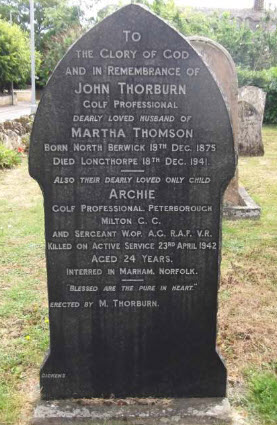
The black granite stone measuring 136cms high x 68cms wide x 10cms deep is inscribed:
TO
THE GLORY OF GOD
AND IN REMEMBRANCE OF
JOHN THORBURN
GOLF PROFESSIONAL
DEARLY LOVED HUSBAND OF
MARTHA THOMSON.
BORN NORTH BERWICK 19TH DEC. 1875
DIED LONGTHORPE 18TH DEC 1941
ALSO THEIR DEARLY LOVED ONLY CHILD
ARCHIE
GOLF PROFESSIONAL, PETERBOROUGH
MILTON G.C.
AND SERGEANT W.OP. A.G. R.A.F.V.R.
KILLED ON ACTIVE SERVICE 23RD APRIL 1942
AGED 24 YEARS.
INTERRED IN MARHAM, NORFOLK.
“BLESSED ARE THE PURE IN HEART”
ERECTED BY M. THOMSON
Archibald John Thorburn (known as Archie) was born on 2/6/1917 in the Houston and Killelen District in Renfrewshire. He was the only child of golf professional John Thorburn and Martha nee Thomson (who had married in 1911).
On the 1939 Registers Archie was working as a golf professional, living at 24 Arundel Road in Peterborough with his parents. Archie was working at Peterborough Milton Golf Club.
In June 1940 Archie joined the Royal Air Force Volunteer Reserve under service number 960871. He served in Bomber Command as a Sergeant (Wireless Operator/Gunner) in 218 (Gold Coast) Squadron.
The 1942 volume of W.R. Chorley’s Bomber Command Losses of the Second World War records that Archie was one of a 7-man crew that took off from RAF Marham in Norfolk at 22:57 on 23/4/1942 in Short Stirling aircraft serial number W7473 HA-F, bound for Rostock. Having lost power from the port engine shortly after take-off, the aircraft turned to the left and crashed at 23:20 in Ingrams Field, about 100 yards from Clenchwarton School near King’s Lynn, killing all aboard.
Archie died on 23/4/1942, aged 24. At his mother’s request, his headstone on grave 16 in Marham Cemetery in Norfolk bears the epitaph “From sky to earth for liberty I fell. I fought, I won my wings again. Farewell”.
Archie’s death was announced on 27/4/1942 in The Scotsman, which described him as the only child of Mrs Martha Thorburn (“late of Peebles”) and her late husband John, and the grandson of Mrs Robert Thomson of Jordanhill, Glasgow.
On 1/5/1942 the Peterborough Standard printed Archie’s obituary on the front page. It mentioned that, although he had only worked at Milton Golf Club from February 1939 to June 1940 when he joined the RAFVR, “He had won the esteem of all the members by his pleasant unassuming manners, his sporting conduct, and his care for the welfare of the game”. Deep sympathy was expressed for Archie’s mother who, after her husband’s death on 18/12/1941, had gone to Scotland to recuperate, and had now been bereaved by the loss of her only child. An official from Milton Club was quoted as commenting that “Archie Thorburn was a fine fellow. [He was] a non-smoker and teetotaller, and following his father’s death, devoted himself to the care of his mother”. The newspaper mentioned that a memorial service for Archiehad been held Longthorpe Church on 30/4/1942.
Archie’s address for Probate was 301 Longthorpe; his mother administered his estate. For unknown reasons, he was not included in the World War 2 Book of Remembrance in Peterborough Cathedral. However, in addition to being commemorated on his father’s headstone at Longthorpe, he is named on a stone tablet on the Memorial Hall at Clenchwarton in Norfolk. He is also commemorated in Scotland on the Peebles Second World War Memorial.
Dennis John Urwin

Corporal Dennis John Urwin has no memorial inside St Botolph’s, but his War Grave is in the north section of the churchyard. (His next-of-kin opted for a stone of their choice rather than having one erected by the Commonwealth War Graves Commission). The inscription on his gravestone reads:
CPL. DENNIS J.
URWIN
GLIDER PILOT REGT.
ACCIDENTALLY
KILLED ON
ACTIVE SERVICE
10TH JAN. 1943
AGED 25 YEARS
Dennis was born in Peterborough on 12/7/1917, the only son of Edwin George Urwin (who was a teacher at Fletton Grammar School) and Kathleen nee Colbert (who was a teacher on the 1911 census). The couple lived at 106 Broadway in Peterborough.
Dennis’ father was an Old Deaconian, and in 1925 Dennis himself became a pupil at Deacon’s School. Its records indicate he was a keen sportsman: he played on the cricket team 1932 to 1934 (as Captain in 1934), and on the rugby team in 1934/1935. He was a prefect in 1934. In 1935 The Deaconian magazine announced that he had left to join his grandfather’s business in Longthorpe (i.e. a garage).
Dennis maintained his interest in sport. He played cricket for Peterborough Town, and was also a very good table-tennis player, winning the local singles championships on two occasions. In 1939 he married Vera May Frost, who had partnered him to win the 1938/1939 mixed-doubles table-tennis championship. After their marriage they lived at 347 Longthorpe; their elder son was born in 1941.
Before the War, Dennis was in the Territorial Artillery. He later joined the Army Air Corps under regimental number 916615, as a Corporal in the 2nd Glider Pilot Regiment. He came home for Christmas 1942. On 13/1/1943 the Western Daily Press reported that three Corporals had been killed by an artillery shell that had been fired from a gun in practice, and which had struck a camp building in Wiltshire; those killed were Francis Burns of Pontypridd, Ernest Hosted of Cleethorpes and Dennis Urwin. The verdict of the inquest was misadventure.
Dennis died from his injuries in Tidworth Military Hospital on 10/1/1943. His funeral was held at Longthorpe Church on 15/1/1943, following which he was buried in the churchyard. At the time of his death, his widow Vera was expecting their 2nd child; he was born a few months later.
The Peterborough Standard printed Dennis’ obituary on 15/1/1943. He is named on the War Memorials of Peterborough All Saints’ and Deacon’s School and in the Book of Remembrance in Peterborough Cathedral. His address for Probate was 347 Longthorpe; his widow administered his estate.


